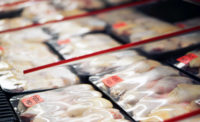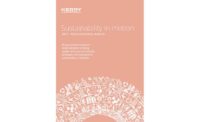Barbecue Index finds consumers exhausted from food inflation
Consumers exhibit greater frugality after experiencing historically high food prices.

Image by Karolina Grabowska from Pixabay
When it comes to their stamina for paying historically high food prices, U.S. consumers are gassed. Having borne the brunt of a protracted post-pandemic inflation runup with extraordinary resilience, Americans have finally hit the wall.
Over the past five years, a series of macro factors have catapulted prices higher, weighing on consumers' wallets and testing their endurance. These hurdles included geopolitical crisis, severe drought, higher restaurant overhead and wages, rising interest rates and higher inflation throughout the supply chain.
As a result, food inflation jumped 25% from 2019 to the end of 2023. But the additional inflation in the first half of 2024 on top of that, albeit far more modest, has been the tipping point. Many consumers who stayed the course by continuing to spend in the face of 40-year highs in food prices are now pulling back and reevaluating their budgets.
"The consumer is waving the white flag on food inflation," said Tom Bailey, senior consumer foods analyst at Rabobank. "With an added 2% in price hikes in 2024 coupled with the cost disparity between dining out and cooking at home at its widest margin in history, we're seeing heightened fatigue and frugality."
 Rabobank
RabobankIndeed, while the overall pace of inflation has moderated to more normal levels since last summer, prices are still moving higher. The 2024 Rabobank BBQ Index, which measures the cost of staple ingredients for a 10-person barbecue, shows that it will cost $99 to host a cookout on the Fourth of July in 2024, up from $97 last year and $73 in 2018. This year, beer, beef, soda and lettuce account for a hefty 64% of total barbecue cost. That brings the inflation gain for a Fourth of July barbecue up to 32% since 2019.
Not surprisingly, fewer Americans are choosing to eat out, as restaurants have passed along higher input costs, wholesale food prices, rent and employee wages to their customers. A reported 68% of people polled by Vericast say they are switching from restaurants — where the tab is up 4.4% annually — to grocery stores, which have seen only a 1.1% price hike. In 2022, U.S. consumers spent more than 11% of their disposable income on food — whether at home or at a restaurant — marking a 30-year high.
For most people, the sticker shock of going out to eat is difficult to stomach. In 2023, 81% of restaurant operators surveyed reported raising their prices in the prior six months. While that number is trending lower in 2024, prices continue to rise.
In many ways, the impact of the rising cost of food is emblematic of the broader economic trend in consumption. Retail sales, a vital sign of the health of the U.S. economy, were weaker than expected in May 2024 as higher borrowing rates and inflation discouraged purchase decisions. In the second half of the year, more of the same is expected. "Retail sales will likely remain soft throughout 2024," Bailey said.
Undoubtedly, the duration of inflation has taken a psychological toll. Consumer sentiment, as measured by the University of Michigan's index, fell to 69.1 in May 2024, marking its lowest level since November 2023. Personal balance sheets have gotten messier too, as wages have not kept pace with inflation. Credit card debt, on average, sits at $10,479 per household — up from $8,763 in 2021 — but still below its all-time high of $12,424. Forty-one percent of Americans polled by WalletHub say they have more credit card debt now than they did 12 months ago.
Excess savings, which soared to an all-time high during Covid, have now sunk to an all-time low as government aid, such as SNAP payments, the child tax credit, increased unemployment benefits and a suspension of student loan payments have ended. People under the age of 35 have been hit the hardest. Credit card delinquencies in this demographic are at their highest level since 2011, according to the Federal Reserve. And rent hikes have eroded the savings that some consumers squirreled away during Covid lockdowns.
"Fiscal fitness is now more of a focus," Bailey said. "Saddled with mounting credit card debt, waning savings and lower real income, consumers are spending less."
The bottom line: A consumer's dollar is not going as far as it did just a few years ago. Consider that the average American has to work an hour to earn enough money for a six-pack of beer and a burger today, up from 51 minutes in 2019. And they'll have to work nine hours to pay for a barbecue this year, up 32% since 2019.
Against this backdrop, families preparing for the time-honored tradition of a backyard barbecue this Fourth of July are increasingly hunting for bargains. In the first half of 2024, many consumers have traded down, reducing the size of their purchases, taking advantage of promotions or delaying big-ticket purchases such as cars and appliances. This trend proved consistent across age groups but was more pronounced among Gen Z and millennials, according to a McKinsey & Co. consumer insights survey. Fifty-six percent of Gen Z and millennial shoppers polled — compared with 45% of older generations — said their primary strategy was to reduce the quantity or package size of the items on their grocery list.
Still, millennials remain prone to giving in to their urge to splurge. Their well-documented willingness to travel and attend pricey concerts reflect this reality even as they have become more selective under the prevailing financial constraints. A reported 78% of millenial respondents polled said they would rather spend money on an experience than material goods. Perhaps the prospect of student loan forgiveness, the pending wealth transfer from the Baby Boomer generation and a "you only live once" mentality may be boosting their penchant for "experiences over things."
Deals
With many consumers forced to exercise more discipline, savvy shopping will come in handy before firing up the grill. "To find bargains in beef this grilling season, look for featured promotions at your local supermarket or club store," said Lance Zimmerman, senior beef analyst at Rabobank. "Beef prices may be at historical highs but many store owners are willing to take a loss by putting various cuts of meat on sale knowing shoppers will fill their carts with other menu items—beer, burgers, hot dogs, sides and salads. They want to boost foot traffic and win loyal customers."
Fortunately for consumers, despite suffering from fatigue from the inflation marathon, they can find deals on quality meats this summer. Recreating a restaurant experience at home is now more palpable as the food industry has made strides in enhancing taste, efficiency and safety.
"The quality of beef available to the consumer has never been better," Zimmerman said. "In the past 20 years, we've seen the availability of USDA prime and choice meat increase 60% as improved cattle management has created more marbling. Those fatty flecks pack a lot of tenderness and flavor while making it easier to grill. Even if you overcook quality meats a little, they won't turn into shoe leather."
Beef versus chicken
The expectation of tighter U.S. beef supplies is leading the market higher as severe drought and challenging business conditions forced U.S. cow-calf producers to liquidate cows over the last five years. Consumer prices should continue to ratchet higher, hitting new record highs throughout the summer grilling season. Higher U.S. prices have caused beef exports to shrink, but domestic beef demand has held up well. Trading down to different cuts and grades of beef — like switching from steaks to burgers — can offset the pinch consumers are feeling from inflation and economic hardship.
In poultry, demand for chicken has improved as consumers seek lower-cost, high-value proteins. Rising beef prices have led many restaurants to offer more chicken options on their menus. Retail stores are also putting more chicken on sale. Breast meat has found its way back to the top of the circular, while lower-cost thigh meat and legs are getting good traction as budget-friendly protein alternatives.
Rationale, methodology
The Rabobank Barbecue Index assumes an average American BBQ situation—a mix of family and friends—on Fourth of July weekend. That includes 10 adults with each consuming the same amount of food and beverages. We assume each person will consume one cheeseburger with lettuce and tomato, one chicken sandwich with lettuce, tomato and a slice of cheese, two handfuls of chips, two beers, a soda and a few scoops of ice cream. As a means of comparison, the BBQ Index parallels the Bureau of Labor Statistics as a data source. We selected the monthly data series "average price index, U.S. city average."
Source: Rabobank
Looking for a reprint of this article?
From high-res PDFs to custom plaques, order your copy today!





